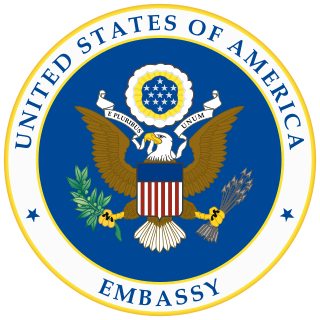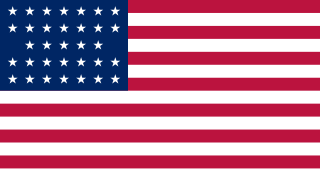
A diplomatic mission or foreign mission is a group of people from a state or organization present in another state to represent the sending state or organization officially in the receiving or host state. In practice, the phrase usually denotes an embassy or high commission, which is the main office of a country's diplomatic representatives to another country; it is usually, but not necessarily, based in the receiving state's capital city. Consulates, on the other hand, are smaller diplomatic missions that are normally located in major cities of the receiving state. As well as being a diplomatic mission to the country in which it is situated, an embassy may also be a nonresident permanent mission to one or more other countries.

The Qing dynasty, officially the Great Qing, was a Manchu-led imperial dynasty of China and the last imperial dynasty in Chinese history. The dynasty, proclaimed in Shenyang in 1636, seized control of Beijing in 1644, which is considered the start of the dynasty's rule. The dynasty lasted until 1912, when it was overthrown in the Xinhai Revolution. In Chinese historiography, the Qing dynasty was preceded by the Ming dynasty and succeeded by the Republic of China. The multi-ethnic Qing dynasty assembled the territorial base for modern China. It was the largest imperial dynasty in the history of China and in 1790 the fourth-largest empire in world history in terms of territorial size. With over 426 million citizens in 1907, it was the most populous country in the world at the time.
The names of China include the many contemporary and historical designations given in various languages for the East Asian country known as Zhōngguó in Standard Chinese, a form based on the Beijing dialect of Mandarin.

The Tangier American Legation, officially the Tangier American Legation Institute for Moroccan Studies (TALIMS), is a building in the medina of Tangier, Morocco that formerly housed the United States diplomatic mission to Morocco. It was the first American public property abroad and is the only U.S. National Historic Landmark in a foreign country.

The Zongli Yamen, short for Office for the General Management of Affairs Concerning the Various Countries (總理各國事務衙門), also known as Prime Minister's Office, Office of General Management, was the government body in charge of foreign policy in imperial China during the late Qing dynasty. It was established by Prince Gong on 11 March 1861 after the Convention of Beijing. It was abolished by the Qing government in 1901 and replaced with a Foreign Office of ministry rank.

The Peking Legation Quarter was the area in Beijing (Peking), China where a number of foreign legations were located between 1861 and 1959. In the Chinese language, the area is known as Dong Jiaomin Xiang, which is the name of the hutong through the area. It is located in the Dongcheng District, immediately to the east of Tiananmen Square.

The Embassy of the United States in Seoul is the diplomatic mission of the United States in the Republic of Korea. The embassy is charged with diplomacy and South Korea–United States relations. The United States Ambassador to Korea is the head of the diplomatic mission of the United States to South Korea.

Australia and Uruguay have had consular relations since 1923 and diplomatic relations since 1948. Australia is represented in Uruguay through its embassy in Buenos Aires (Argentina). Uruguay has an embassy in Canberra a consulate general in Sydney.
The Korean Joseon dynasty (1392–1897) sent numerous diplomatic missions to the Chinese Ming (1368–1644) and Qing (1644–1912) dynasties.

This is a summary history of diplomatic relations of the United States listed by country. The history of diplomatic relations of the United States began with the appointment of Benjamin Franklin as U.S. Minister to France in 1778, even before the U.S. had won its independence from Great Britain in 1783.

The Embassy of the People's Republic of China in the United Kingdom of Great Britain and Northern Ireland is the diplomatic mission of China in the United Kingdom, located in London. Established in 1877 as the Chinese Legation, the London mission was China's first permanent overseas diplomatic mission. It has served as the diplomatic mission of the Manchu Qing Empire, the Republic of China, and the People's Republic of China. It was the location of the Qing Empire's detention of Sun Yat-sen, an important episode in the Chinese revolution of 1911. It remains today the focal point for events relating to China held in the United Kingdom, including celebrations in 2012 to commemorate 40 years of diplomatic relations between the UK and the People's Republic of China.

The Embassy of the United Kingdom in Beijing is the chief diplomatic mission of the United Kingdom in the People's Republic of China. It is one of Britain's largest overseas embassies. It is located at 11 Guanghua Road, in the Chaoyang District. The current British Ambassador to China is Caroline Wilson.

The Qing dynasty was an imperial Chinese dynasty ruled by the Aisin Gioro clan of Manchu ethnicity. Officially known as the Great Qing, the dynastic empire was also widely known in English as China and the Chinese Empire both during its existence, especially internationally, and after the fall of the dynasty.

The Embassy of Mexico in China, based out of Beijing, is the primary diplomatic mission from the United Mexican States to the People's Republic of China.

In 1861, Prussia and the Qing dynasty signed the first Sino-German treaty during the Eulenburg Expedition, leading to the beginning of the activities of German trading companies in Taiwan. The Federal Republic of Germany established diplomatic relations with the Republic of China (Taiwan) in 1955. After recognizing the People's Republic of China in 1972, the two countries maintain unofficial diplomatic relations.

The American concession of Tianjin was a territory (concession) in the Chinese city of Tientsin de facto occupied by the United States between the 1860s and 1901 in present-day Xiaobailou Subdistrict. American administration of the settlement existed in a legal gray area where no material paperwork ever existed to demarcate the concession, and its existence was only made possible by acknowledgement by all sides: the United States, the Qing dynasty, and other local concession municipal governments, including the German, Russian, and British concessions.













